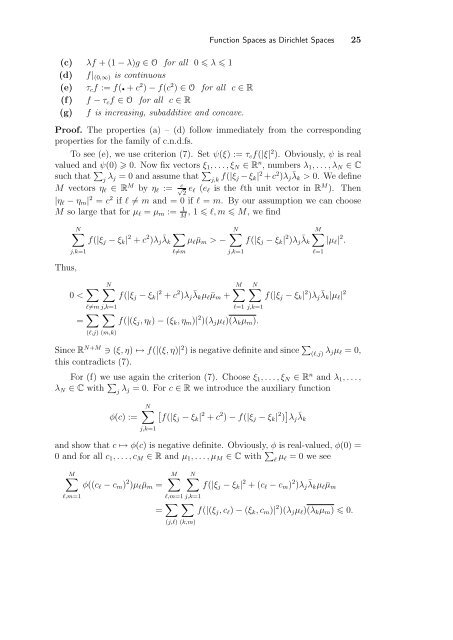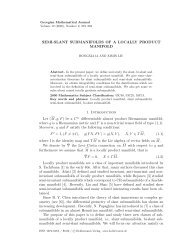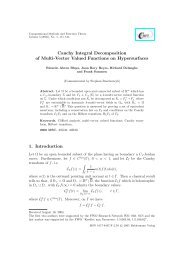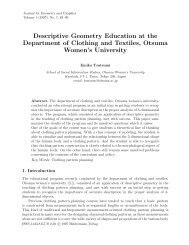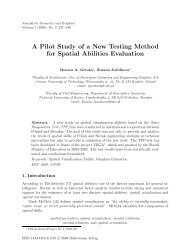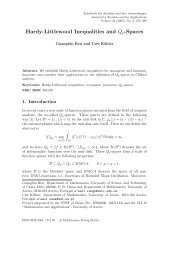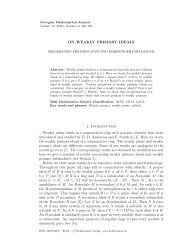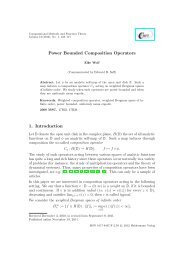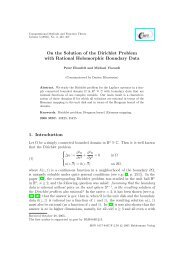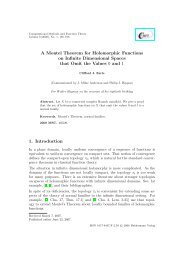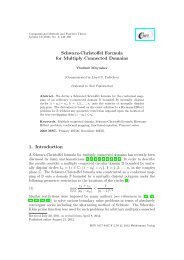Function Spaces as Dirichlet Spaces (About a Paper by Maz'ya and ...
Function Spaces as Dirichlet Spaces (About a Paper by Maz'ya and ...
Function Spaces as Dirichlet Spaces (About a Paper by Maz'ya and ...
Create successful ePaper yourself
Turn your PDF publications into a flip-book with our unique Google optimized e-Paper software.
(c) λf + (1 − λ)g ∈ O for all 0 λ 1<br />
(d) f| (0,∞) is continuous<br />
(e) τ c f := f(• + c 2 ) − f(c 2 ) ∈ O for all c ∈ R<br />
(f) f − τ c f ∈ O for all c ∈ R<br />
(g) f is incre<strong>as</strong>ing, subadditive <strong>and</strong> concave.<br />
<strong>Function</strong> <strong>Spaces</strong> <strong>as</strong> <strong>Dirichlet</strong> <strong>Spaces</strong> 25<br />
Proof. The properties (a) – (d) follow immediately from the corresponding<br />
properties for the family of c.n.d.fs.<br />
To see (e), we use criterion (7). Set ψ(ξ) := τ c f(|ξ| 2 ). Obviously, ψ is real<br />
valued <strong>and</strong> ψ(0) 0. Now fix vectors ξ 1 , . . . , ξ N ∈ R n , numbers λ 1 , . . . , λ N ∈ C<br />
such that ∑ j λ j = 0 <strong>and</strong> <strong>as</strong>sume that ∑ j,k f(|ξ j − ξ k | 2 + c 2 )λ j¯λk > 0. We define<br />
M vectors η l ∈ R M <strong>by</strong> η l := √ c<br />
2<br />
e l (e l is the lth unit vector in R M ). Then<br />
|η l − η m | 2 = c 2 if l ≠ m <strong>and</strong> = 0 if l = m. By our <strong>as</strong>sumption we can choose<br />
M so large that for µ l = µ m := 1 , 1 l, m M, we find<br />
M<br />
N∑<br />
∑<br />
N∑<br />
f(|ξ j − ξ k | 2 + c 2 )λ j¯λk µ l¯µ m > − f(|ξ j − ξ k | 2 )λ j¯λk<br />
j,k=1<br />
l≠m<br />
j,k=1<br />
M<br />
∑<br />
l=1<br />
|µ l | 2 .<br />
Thus,<br />
0 < ∑ N∑<br />
M∑ N∑<br />
f(|ξ j − ξ k | 2 + c 2 )λ j¯λk µ l¯µ m + f(|ξ j − ξ k | 2 )λ j¯λk |µ l | 2<br />
l≠m j,k=1<br />
l=1 j,k=1<br />
= ∑ ∑<br />
f(|(ξ j , η l ) − (ξ k , η m )| 2 )(λ j µ l )(λ k µ m ).<br />
(l,j) (m,k)<br />
Since R N+M ∋ (ξ, η) ↦→ f(|(ξ, η)| 2 ) is negative definite <strong>and</strong> since ∑ (l,j) λ jµ l = 0,<br />
this contradicts (7).<br />
For (f) we use again the criterion (7). Choose ξ 1 , . . . , ξ N ∈ R n <strong>and</strong> λ 1 , . . . ,<br />
λ N ∈ C with ∑ j λ j = 0. For c ∈ R we introduce the auxiliary function<br />
φ(c) :=<br />
N∑ [<br />
f(|ξj − ξ k | 2 + c 2 ) − f(|ξ j − ξ k | 2 ) ] λ j¯λk<br />
j,k=1<br />
<strong>and</strong> show that c ↦→ φ(c) is negative definite. Obviously, φ is real-valued, φ(0) =<br />
0 <strong>and</strong> for all c 1 , . . . , c M ∈ R <strong>and</strong> µ 1 , . . . , µ M ∈ C with ∑ l µ l = 0 we see<br />
M∑<br />
l,m=1<br />
φ((c l − c m ) 2 )µ l¯µ m =<br />
M∑<br />
l,m=1 j,k=1<br />
= ∑ (j,l)<br />
N∑<br />
f(|ξ j − ξ k | 2 + (c l − c m ) 2 )λ j¯λk µ l¯µ m<br />
∑<br />
f(|(ξ j , c l ) − (ξ k , c m )| 2 )(λ j µ l )(λ k µ m ) 0.<br />
(k,m)


